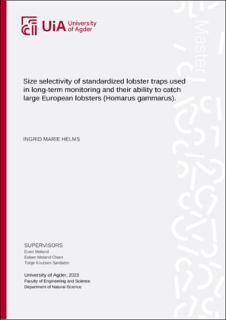| dc.description.abstract | Harvesting the resources of the ocean has been an integral part of both human settlement and advancements for millennia. In later years, the effects of unsustainable harvesting have become clearer, and several management regulations have been sanctioned to preserve populations that are being threatened by overfishing. One of these management regulations is Marine protected areas (MPAs). In Norway, the Flødevigen lobster reserve was established in 2006 to study the effect of protection on the local European lobster (Homarus gammarus) population. The population has since increased in both numbers and size, but lately the maximum observed body size of lobsters within the reserve has been stagnating at around 400 millimeters (mm). In this study, the sampling method used in Norwegian lobster reserves was tested and evaluated. This was done to see whether the standard traps used to survey lobsters have been under-sampling the larger individuals through gear selectivity. This was done by introducing 10 collapsible fish traps with a substantially larger entrance funnel (270mm) to each day of sampling. The results show that there was an up to 10% difference in the body size of the lobsters caught in the standard traps compared to the larger fish traps. The large fish traps also caught 50% of the lobsters over 400 mm. This strongly suggests that the standard traps used in monitoring are size selective against large lobsters, and that traps with a larger funnel are better than smaller funnels at catching large lobsters. Testing revealed that the fish trap was more effective at catching the largest male lobsters, especially those with larger claws, which the standard traps mostly failed to catch. The presence of these large individuals may offer new perspectives on the effectiveness of the protection of European lobsters in Norway. This study demonstrates the importance of precise sampling methods when studying effects of conservation. | |
